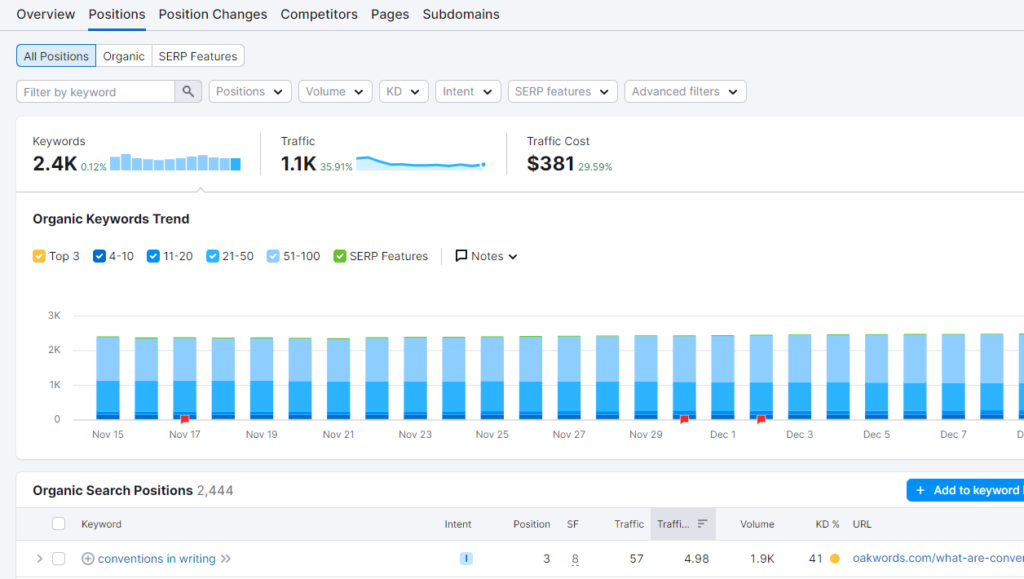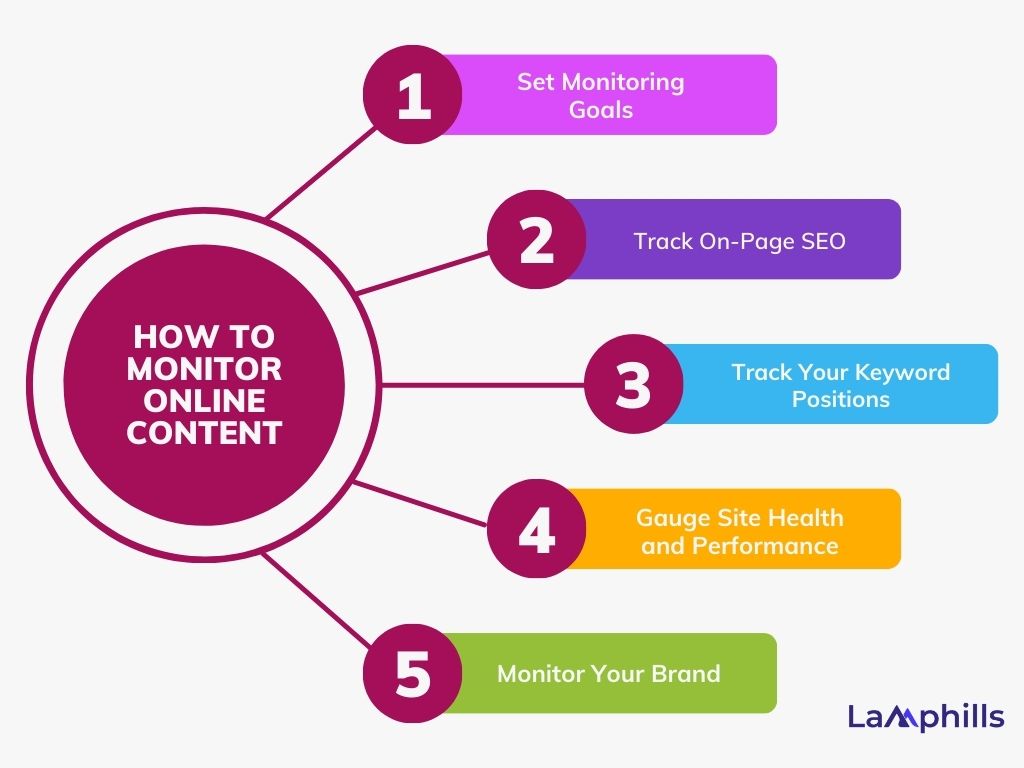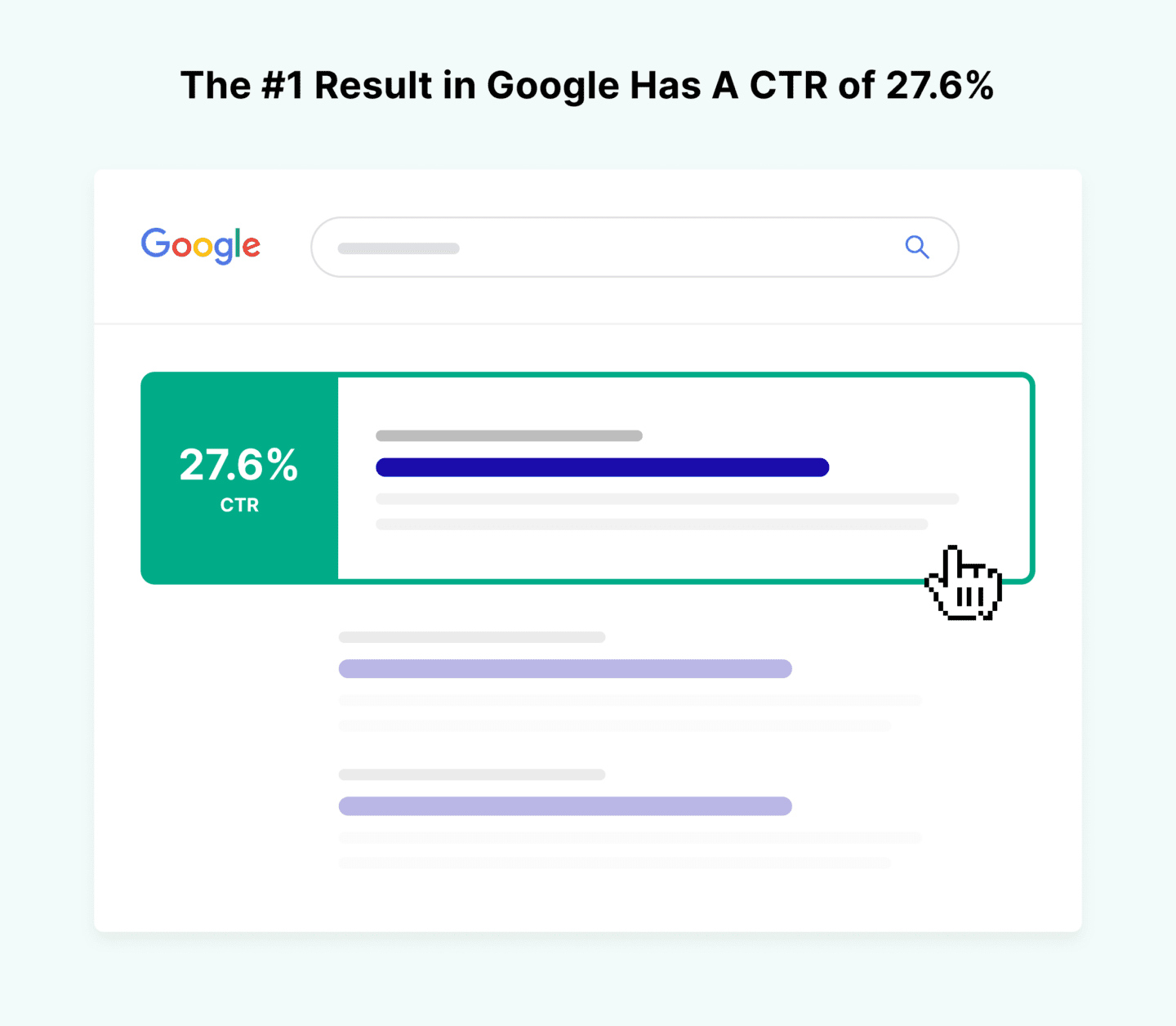What is online content monitoring all about? Before I answer that, though, I need to ask you a question of my own: what is the value of your business’ online content? Yes, it may be captivating, eloquent, and well-written, but does it generate leads and conversions, or is it just sitting there, looking pretty?
That is the value of online content monitoring.
Yes, your content might be the best, but all of that means naught if it isn’t reaching the right audience—if it isn’t leading to conversions and clicks and leading people to your site in droves.
No matter how beautiful a piece of art is, it is wasted if people don’t troop in to see it.
Key Points
- Content monitoring is the practice of analyzing the performance of articles, landing pages, and other content assets across your website.
- It also includes monitoring social media by collecting social conversations and messages into a database of useful information.
- Pages you should monitor include your public websites, business partners’ websites, competitors’ websites, and affiliate pages.
- Online content monitoring involves keeping track of various aspects of a website to ensure its performance, security, and compliance with policies.
- Online content monitoring has higher search engine rankings and improved keyword optimization, among other benefits.
What Is Online Content Monitoring?
Content monitoring is the practice of analyzing the performance of articles, landing pages, and other content assets across your website. It also includes monitoring social media by tracking hashtags, keywords and mentions relevant to your brand to stay informed about your audience and industry.
This can provide actionable insights to iterate your strategy and improve your content.
For example: let’s say you monitor your blog regularly and find multiple posts with a high bounce rate or low engagement. This could mean your content doesn’t resonate with your audience. You can use analytics tools to identify potential issues, adjust, and reevaluate.
Remember, measuring content performance shows how users actually perceive the content on your website and how well it drives important outcomes (e.g., impressions or conversions).
Read also: Social Media Engagement: 7 Interactive Post Ideas That Helped Us.
Social Media Monitoring
Social media monitoring is the process of collecting social conversations and messages into a database of useful information. You may also react to each message you read individually, addressing concerns, complaints, and questions on each channel.
By monitoring social media data, you’re doing research that is both quantitative (metrics and analytics) and qualitative (inspiration for posts and strategies). You’ll get information that can help you determine things like:
- Social share of voice (i.e. what percentage of the conversation is about you, as opposed to being about your competitors)
- Social sentiment analysis (i.e., what’s the mood of the conversation)
- Social ROI (i.e., how much your dollar investment in social is paying off)
- Relevant hashtags and keywords (i.e., which Instagram hashtags or YouTube keywords you might want to use in the future to expand your reach)
- Trends (i.e., what is your audience talking about, what new ideas, aesthetics, or memes are popping up, are the platforms offering new tools and services, etc.)
The term “social monitoring” is often used interchangeably with social listening. While both terms refer to a form of social media intelligence, they don’t mean the same thing. Monitoring tells you what your customers are saying. Listening tells you why those conversations are happening.
Types Of Online Content You Should Monitor
There are so many sources of information online, and trying to monitor all of them could be counter-productive. Hence, I have highlighted the web pages I believe are the most valuable to watch, as they could impact your business.
Your public website
Anything can happen, from a release gone wild to an integration breaking (especially when using third-party scripts or plugins). Keeping an eye on your website’s essential pages is naturally a good practice. You should monitor the following:
- Home page – undoubtedly one of your website’s most crucial entry doors.
- Pricing page – usually a critical page where signup and sales originate
- The most important landing pages – often those that drive the most traffic and conversion.
- Contact form – another critical touch point for your visitors you want to keep in check.
- Any significant documentation page, if any – as they have a tremendous impact and your SEO and conversion too.
Business partners’ websites
Your business partners are most likely essential for your service delivery, its quality, or even your customer acquisition. Potentially they also matter from a sales perspective or are significant for your costs. You better stay proactive there and monitor their activity at all times.
- Pages where your product & services might be listed – to ensure you’re still there and eventually find out when another (potentially competing) product lands there too.
- API Documentations – to get alerted on a change of specifications, an update, or a new feature addition. This could give you an edge to improve your integrations or save you troubleshooting time as you’ll identify exactly what changed.
- Pricing page – to get alerted on any change of offering.
- Terms of services – to keep legal or compliance things in check.
Competitors’ websites
A little heads-up always helps!
- Home page – the #1 place where announcements or messaging changes are made.
- Pricing page – to get alerted on any change of offering or pricing
- Terms of services – important updates are often published there: change of ownership, change of terms, new activities … information that wouldn’t necessarily be published anywhere else or a long time after.
- About us or Team page – A change of management or culture/policy can reveal a shift in strategy that you’d want to be aware of.
Affiliates & Referrals web pages
Either from an SEO standpoint or more generally regarding your branding, monitoring mentions of your brand and services helps to identify changes in trends or market positioning.
- Blog posts mentioning you/your competition – they are more and more dynamic, with a change of content or simple deletion for SEO optimization. Such an update can affect your traffic (acquisition) or reveal an update on your market: new competitor or change of offering.
- Media Articles – whether paid or not, you want these pages to stay online without editing, as they are essential for your branding.
- Online Reviews – to stay alert on your competitiveness and potentially identify new challengers in your market. People like to compare services and provide insightful feedback. Knowing where you stand and if reactions to your services are changing can prove valuable.
With this list of web pages on watch and constant monitoring, you can be pretty confident you won’t miss an important market signal, have a strong information powerhouse for your business, and have peace of mind about your website look & feel.
Content Marketing Metrics You Must Track
Online content monitoring involves keeping track of various aspects of a website to ensure its performance, security, and compliance with policies. Here are some key areas you should consider monitoring:
1. Uptime and Availability:
- Ensure that your website is accessible to users.
- Monitor for downtime and receive alerts when the site is unreachable.
2. Page Load Times:
- Track the loading speed of your web pages.
- Identify and address slow-loading pages to enhance user experience.
3. Broken Links:
- Regularly check for broken links and fix them promptly.
- Broken links can negatively impact SEO and user experience.
- You can see broken backlink analysis on SEMrush:

4. SEO Performance:
- Keep an eye on search engine rankings for important keywords.
- Monitor organic traffic and identify opportunities for optimization.
- You can use tools like SEMrush to track the organic search positions of your content. For example:

5. Security:
- Scan for malware, vulnerabilities, and security issues.
- Ensure that SSL certificates are valid and up to date.
6. User Experience (UX) and Page Experience:
- Analyze user behavior and engagement on your site.
- Identify areas for improvement in the user interface and overall experience.
- With Google Search Console, you can identify how your website is performing on different screens and what changes you need to make it better:

7. Content Quality:
- Monitor the quality and relevance of your content.
- Ensure that information is accurate and up to date.
8. Performance Analytics:
- Use tools like Google Analytics/Google Search Console to analyze user behavior, traffic sources, and conversion rates.
- Make data-driven decisions to improve website performance.
For example, the data below shows that the total number of web search clicks has declined over the month:

9. Social Media Mentions:
- Monitor social media channels for mentions of your brand or website.
- Respond to and address any issues or concerns raised by users.
10. Mobile Responsiveness:
- Check and ensure that your website is responsive on various devices.
- Monitor mobile-specific metrics, as a growing number of users access websites through mobile devices.
How to Monitor Content Online In 5 Steps

Just getting started with online content monitoring and wondering how to go about it? Well, you’re in luck. I have put together a detailed guide to take you through the steps you need to follow. Check it out below:
How to Monitor Online Content
Benefits of Online Content Monitoring
How exactly does content monitoring unlock actionable insights, improving the performance of your websites? Let’s look at a few examples.
1. Higher search engine rankings
Website content monitoring can boost search engine rankings by helping you:
- Optimize keyword targeting to increase your chances of people finding your page
- Create high-quality, user-friendly content aligned with search intent
- Analyze performance metrics and make data-driven improvements to your content
- Track competitor strategies to keep your edge in the market
The higher your content ranks on the search engine results page (SERP), the more eyeballs your page can draw organically.
Impressions and visits to your pages via Google and other search engines translate to organic traffic. Also, more organic traffic means more opportunity to generate conversions like:
- Form fills
- Demo requests
- Newsletter subscriptions
- Self-assisted purchases
Backlinko found ranking first on the SERP yields an average click-through rate (CTR) of 27.6%. Ranking 10th brought a CTR 10 times smaller.

2. Improved keyword optimization
Keyword optimization is the process of identifying and including the most relevant keywords in your website’s content.
Having keyword-optimized content increases your website’s visibility and discoverability. Why? Because search engines use keywords to understand the relevance of your content to user searches. Using the right keywords can help your pages rank higher and attract more targeted organic traffic.
Monitoring keyword rankings allows you to identify all keywords and phrases driving traffic to your site. Then you can find the keywords with the highest search volume or highest intent and prioritize them.
For instance, you may discover that you rank on page two for the keyword “best solar panels.” With this information, you can optimize your content around this high-volume keyword to increase traffic and conversions by attracting users looking for this product.
3. Insights from competitor analysis
A competitor analysis reveals features, market share, strengths, weaknesses, and gaps to use to your advantage. By monitoring competitors, you learn:
- The keywords your competitors target
- The channels that perform best for the audience
- Which social networks and hashtags work best for engagement
- The influencers who work closely with the brand
- Competitor keyword rankings
- Competitor most-shared content
In-depth competitor analysis also helps you catch up on industry trends. Staying on top of trends prepares you for any changes that could affect your business, like shifting consumer preferences or product launches.
4. Enhanced user engagement
Content monitoring plays a pivotal role in keeping website content fresh, relevant, and engaging. Regularly updated and captivating content encourages visitors to spend more time on the site, reducing bounce rates and increasing overall user engagement.
This not only positively influences search engine rankings but also contributes to the establishment of a loyal audience.
By analyzing user interactions and feedback, businesses can tailor their content to meet the evolving needs and preferences of their audience, fostering a stronger connection with users.
5. Alignment with user intent
Aligning content with user intent matches your content to specific user needs, interests, and search queries.
Intent is an important ranking factor. If your blog post appears on the SERPs and the content doesn’t align with what the searcher wants, they’ll probably leave your site. That increases your bounce rate, which can impact your organic ranking.
For example: If your blog post targets the keyword “best budget laptops,” but the content primarily focuses on high-end laptops, users searching for budget options will likely leave your site.
Monitoring metrics like bounce rate can ensure your content aligns with the expectations of your target audience.
6. Mitigating algorithm updates impact
Google and other search engines are constantly deploying updates to their search algorithms. Hence, staying on top of these updates helps you anticipate potential impact on your rankings, visibility, and traffic.
For example, an algorithm update can cause you to pivot your content and search engine optimization (SEO) strategies. When Google’s Core Web Vitals emerged, many websites had to adjust their page experience to meet the new ranking criteria.
Staying informed about algorithm updates allows you to adapt your content proactively. You want your website to comply with the latest guidelines.
Best Content Monitoring Tools
Content monitoring tools are essential for keeping track of your website’s performance, user engagement, and overall content effectiveness. Here are the top content monitoring tools that can significantly enhance your ability to analyze and improve your online presence:
1. Google Analytics
Google Analytics is a powerhouse when it comes to content monitoring. It provides a comprehensive overview of your website’s performance, including user behavior, traffic sources, and conversion metrics.
With features like goal tracking and event monitoring, you can measure the success of your content in achieving specific objectives.
The platform’s user-friendly interface and customizable reports make it an indispensable tool for content marketers and website administrators.
2. SEMrush
SEMrush is an all-in-one marketing toolkit that offers robust features for content monitoring. It allows you to track your website’s keyword rankings, analyze backlinks, and conduct competitive research.
SEMrush’s content audit tool helps identify content gaps, while its SEO Writing Assistant provides real-time suggestions to optimize your content for search engines.
With its in-depth analytics and competitor benchmarking, SEMrush empowers users to refine their content strategy for maximum impact.
3. Brandwatch
Brandwatch is a social listening and analytics platform that goes beyond traditional content monitoring tools. It enables you to track brand mentions, sentiment, and industry trends across social media, forums, blogs, and news sites.
Brandwatch’s comprehensive analytics and customizable dashboards provide a holistic view of your brand’s online presence, making it a valuable tool for reputation management and content optimization. By understanding how your brand is perceived online, you can adapt your content strategy to align with audience sentiment.
4. BuzzSumo
BuzzSumo focuses on content discovery and social media monitoring. It helps you identify trending topics, popular content, and key influencers in your industry. It also provides social engagement metrics, allowing you to gauge the impact of your content across various platforms.
This tool is particularly useful for content creators looking to stay ahead of trends and create shareable, engaging content.
By analyzing the performance of specific topics or keywords, you can tailor your content strategy to align with audience interests.
5. Moz
Moz is a comprehensive SEO tool that includes features specifically designed for content monitoring. It offers insights into keyword rankings, on-page optimization, and backlink profiles.
Moz’s Site Crawl tool helps identify technical issues that may impact your content’s performance. The Page Optimization feature provides actionable recommendations to enhance individual pages.
Moz Pro is known for its accuracy in tracking keyword positions and providing valuable recommendations for improving content visibility.
Recommended Articles
- 10 BEST SOCIAL MEDIA MONITORING TOOLS IN 2024
- Marketing vs. Advertising: Building a Growth Engine for Your Business
- THE ULTIMATE GUIDE TO OWNED MEDIA: Best Strategies & Examples
- Spam Backlinks: The Silent Saboteurs of Your Website’s Credibility






